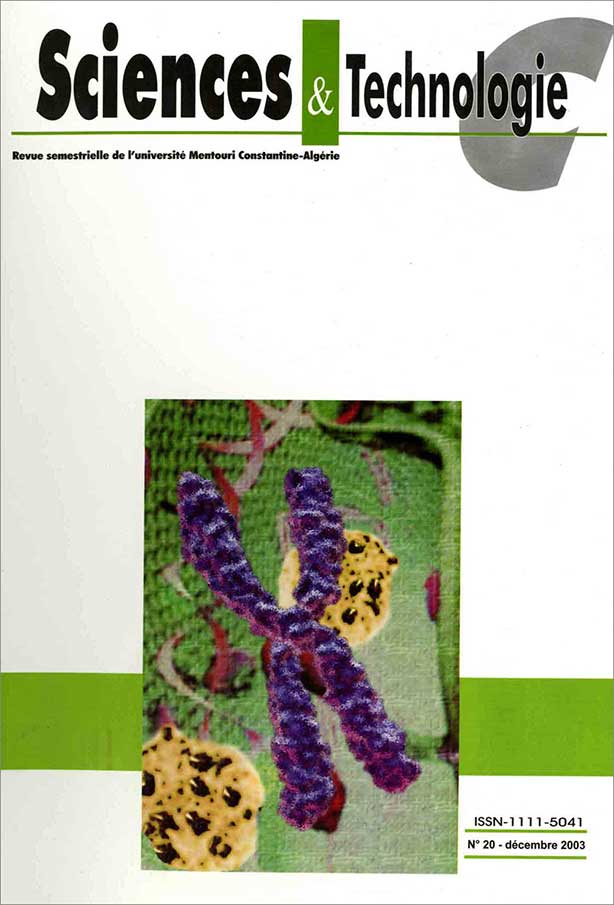EFFET DES BAREMES DE STERILISATION SUR LA QUALITE BIOCHIMIQUE ET NUTRITIONNELLE DES TOMATES EN CONSERVE
Mots-clés :
Tomato, heat treatment, Brix, sugars, proteins, Ascorbic acid, Tocopherol, Lycopene, Antioxydants, Bostwick viscosity, A.C.P.Résumé
Les études épidémiologiques attestent l’existence d’une corrélation positive entre la consommation des produits à base de tomate riches en caroténoïdes et la diminution du risque de développement de certaines pathologies telles que cancer et athérosclérose. Ceci fait des produits dérivés de la tomate des aliments de valeur nutritionnelle très intéressante. Dans notre étude, nous nous somme intéressés à l’évaluation de l’effet de deux traitements technologiques de stérilisation sur la qualité physico-chimique et nutritionnelle des conserves de double concentré de tomate. Pour cela, notre choix s’est porté sur l’évaluation des certains critères physico-chimiques et nutritionnels : teneurs en Brix, en sucres, en protéines, en chlorures, en acide critique et en antioxydants : Acide Ascorbique, en Lycopène et en tocophérol. Il ressort que les barèmes les plus agressifs (T° élevées et temps courts) sont plus astreignants sur la qualité nutritionnelle, telle que : teneur en matière sèche soluble (Brix), teneurs en protéines et en sucres et teneur en vitamines hydrosolubles.Références
- Agarwal S. and Rao A.V., "Tomato lycopene and its role in human health and chronic diseases", CMAJ, 163(6), (2000), pp. 739-744.
- Bodnar J. et Garton R.W., "Production de tomate de consommation en frais", Fiche technique ISSN 1198-7138 du Ministère de l’agriculture, de l’alimentation et des affaires rurales de l’Ontario. Agdex 257/20, N°94-020, (1994).
- Chaux C. et Foury C., Productions Légumières : Légumineuses potagères. Légumes fruits." Collection Agriculture d’aujourd’hui, Sciences, Techniques, Applications. Editions Lavoisier-Tec-Doc., Paris, 3(3) (1994), pp.145-231.
- Conn P.F., Schalch W. et Truscott T.G., "The singlet oxygen and carotenoid interaction", Ann N .Y. Acad. Sci., 31, 691, (1993), pp. 10-19.
- Eichner K., Reutter M., Wittmann R., "Detection of Amadori compounds in heated foods", J. Food Proc. Pres., 543, (1994), pp.42-54.
- Eichner K., Schrader I., Lange M., "Early detection of changes during heat processing and storage of tomato products", Am. Chem. Soc., (1996), pp. 32-44.
- Gallais A. et Bannerot H., "Amélioration des espèces végétales cultivées: objectifs et critères de sélection", INRA. (1992), pp. 379-391.
- Gerber M., "A role for tomatoes and lycopene in the protection from chronic degeneratives diseases? The result of epidemiological studies". In: Role and control of antioxidants in the tomato processing industry, second bulletin on the advancement of research. A European Commission concerted action programme FAIR CT 97, 3233, (1999), 6p.
- Grolier P., "Antioxidants in the tomato fruit. In: Role and control of antioxidants in the tomato processing industry", Second bulletin on the advancement of research. A European commission concerted action programme FAIR CT 97-3233, (1999), 4p.
- Grolier P., Bartholin G., Broers L., Garis-Veyrat C., Dadomo M., Di Lucca G., Dumas Y., Meddens F., Sandei L., Schuch W., "Les anti-oxydants de la tomate et leur biosynthèse", In : Les antioxydants de la tomate et ses dérivés et leur benfaits pour la santé. Le livre blanc de la tomate, action concertée de la commission européenne, FAIR CT 97-3233. (2000), 3p.
- Hawbecker D.E., "Microbiology, packaging, HACCP & ingredients", Plant Quality control. Comstock Michigan
Fruit Div., (7) (1995), pp.261-283.
- Kaegi E., "Unconventional therapies for cancer Vitamins A, C and E – on behalf of the Task force on Alternative therapies of the Canadian Breast cancer research initiative", CMAJ., 158, (1998), pp. 1483-1488.
- Matos H.R., "Protective effect of lycopene on lipid peroxidative DANN", Arch. Bioch. Bioph., 383 (1), (2000), pp.56-59.
- Mitchell J. and Hill S., "The use of antioxidants to control polysaccharide molecular weight loss", Food News. University of Nottingham, (1991), p.29.
- Nguyen M.L. and Schwartz S.J., "Lycopene stability during food processing", Proc. Soc. Exp. Biol. Med., 218 (2), (1998), pp.101-105.
- Pascaud M., "Vitamines", Encyclopaedia Universalis, version 4.0, France (1998).
- Rougereau A., "Technique d’analyse et de contrôle de la qualité dans l’industrie agro-alimentaire", TEC DOC, Lavoisier éd., 5 (1981), pp.246-247.
- Ruasse J.P., "Comportement alimentaire : Hygiène alimentaire", Encyclopaedia Universalis, Version 4.0, France (1998).
- Shrama S.K. and Le Maguer M., "Kinetics of lycopene degradation in tomato pulp solids under different processing and storage conditions", Food Res. Int., 29 (3-4), (1996), pp.309-315.
- Smith H.R., "The consistency of tomato catsup", The canning trade, 54 (1), (1961), pp.4-17.
- Stahl W, Sies H., "Uptake of lycopene and ist geometrical isomers is greater from heat-processed than from unprocessed tomato juice in humans", J. Nutr., 22 (11), (1992), pp.2161-2166.
- Stahl W. and Sies H., "Lycopene: a biologically important carotenoid for humans ?" Arch. Biochem. Biophys., 336 (1), (1996), pp.1-9.
- Stahl W., "Lycopene: Biovailibility and biological properties", In: Role and control of antioxidants in the tomato processing industry, second bulletin on the advancement of research. A European commission concerted action programme FAIR CT 97-3233, (1999), 2p.
- Teodorescu L., "Recherches sur les réactions entre le fructose et les acides aminés", Ind. Agro Alim. 108 (1), Juillet/Août (1991), p^p.587-592.
- Thioulouse J., Chessel D., Dolédec S. et Olivier J.M., ADE-4, version W 1.0, Université de Lyon-1, France, (1999).
- Tonucci L.H., Holden J.M., Beecher G.R., Khachik F., Davis C.S. and Mulokzi G., "Carotenoid content of thermally processed tomato-based food products", J. Agric. Food Chem., 43, (1995), pp.579-586.
- Veera C. and Sangchai S., "Study of fluid flow and heat transfer properties of tomato paste", King Mongkut’s Inst. of Technology, Thesis B. Eng in chemistry, (1987).
- Weisberg S., "Minitab reference manual". P.A. states college, Minitab, (1985), p.232.
